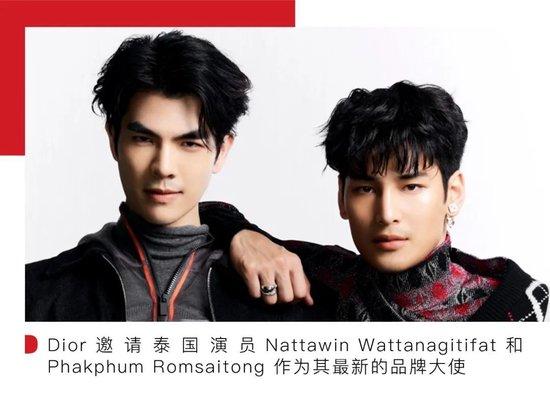Original title: Business Insight | "Cold thinking" behind the Asian star endorsement craze
Reprinted from: WWD International Fashion News
In the current world of "traffic is king", the binding relationship between luxury brands and stars is gradually deepening, and the proportion of Asian faces is increasing.
At the beginning of this year, Dior signed with JiMin, a member of BTS, as the global ambassador; LV signed a contract with J-Hope, a BTS member, and asked him to participate in the promotion of Keepall package; Valentino appointed Suga, a BTS member, as the brand ambassador; Givenchy appointed Taeyang, a member of Big Bang, as its latest brand ambassador.
Recently, the appointment of luxury brands has become more intensive. Bvlgari announced that Liu Yifei, a famous actress, officially joined the Bulgari family as the spokesperson of global brands; Golden Goose is pleased to announce that SUNMI Xuanmei has become the global spokesperson of the brand; Valentino announced that actor Yang Yang became the brand spokesperson; Tory Burch announced actor Qin Lan as the brand spokesperson; Boucheron announced that Korean actor Han Shaoxi became the spokesperson of the brand new; Gucci recently officially announced that Bollywood actress Alia Bhatt is the first global brand ambassador from India; Loewe signed with Taeyong, a Korean pop singer and member of South Korean men's group NCT, as the brand's global image ambassador; Dior invited Thai actors Nattawin Wattanagitifat and Phakphum Romsaitong as his latest brand ambassadors

Luxury brands that have always made good use of European and American stars have recently cooperated with many top Asian brands, constantly changing the marketing direction, and the answer to who needs more between luxury brands and stars is gradually blurred. In the era of social media explosion, barriers between national boundaries have weakened, and many Asian stars have gone to the international stage with certain international influence, becoming fashion vane and mobile show room. Celebrity endorsement has become a rampant means in the market, while luxury brands seem to be trapped in the strange circle of chasing traffic, and the scope of endorsement is changing.
The global luxury market is undergoing rebalancing.
Previously, a consulting company and Altagamma, the Italian luxury goods manufacturers' industry association, jointly released a research report entitled "Research on the Global Luxury Market in Spring 2023", which showed that due to economic uncertainty, luxury consumption in the United States is slowing down, while the first quarter of 2023 still increased by 9% - 11% compared with the same period of 2022, The study attributed its growth to China's reopening and the cancellation of epidemic prevention policies before the Spring Festival shopping season, as well as the promotion of tourism in the region by Japan and Southeast Asia. The recovery momentum and consumer confidence in Asia should not be underestimated.

Luxury and fashion business experts clearly said: "The luxury industry is going through a new stage after the growth after the epidemic, and the new elastic driving force determines the 'winners' and' losers'. Brands who want to succeed need to Fully focus on consumers, balance risk exposure in different regions, provide high value propositions, improve entry-level customer base and large-scale experience, and launch classic, timeless and personalized pieces. "
Despite the uncertainty of the economic situation, the personal luxury market will still grow by 5-12% in 2023. Among them, the Chinese mainland market grew in the first quarter, and Southeast Asia also achieved sustained growth due to the influx of Russian tourists, the return of the first batch of Chinese consumers, and strong demand for jewelry and watches. The Korean market is growing steadily, while Japan is becoming a rising star.
In the face of the incremental market with unlimited potential, luxury brands have to focus on Asia, the "Vanity Fair".
First, I want to ask whether luxury brands can "penetrate" the Asian market?
Second, can luxury brands "penetrate" the Asian market through star icons?
Luxury brands often play a marginal role in "Asian discrimination". But from the perspective of "businessmen", losing the Asian market is like losing a big slice of the cake# StopAsianHate # campaign has received a large number of public responses, and this concept also coincides with the desire of the United States to give up advertising to Europeans. The recognition and cooperation of luxury brands to Asian faces is more like a political process - trying to gain the favor of a strong Asian market.
At this time, idol stars, as carriers, become "middlemen" for communication between brands and consumers. From Adorno's critical perspective, idol stars can be seen as the product of cultural industry. They seem to be born from popular culture, which is fundamentally determined by political and economic factors. They regard public awareness and aesthetics as the market, and public awareness and aesthetics are forced to accept such a unified business model.
Both Bollywood actress Alia Bhatt became the first global brand ambassador from India for Gucci brand to help the brand better grasp the Indian market opportunities; Or Dior invited Thai actors Nattawin Wattanagitifat and Phakphum Romsaitong as their latest brand ambassadors to meet the expectation that the Thai luxury market is expected to reach 4.6 billion dollars in 2023; Or Loewe signed with Taeyong, a Korean pop singer and member of South Korean men's group NCT, as the global image ambassador of the brand to continue to consolidate the huge market in South Korea. Luxury brands put their naked profit motive on the cooperation with Asian stars, and developed it as the core market.

Idol stars belong to the cultural industry, which is the most effective competitive tool in the global business war. Luxury brands transmit aesthetic signals through cooperation with star idols, so that consumers in different countries can find aesthetic identity and aesthetic mapping in the endorsement of their idols, and leverage political penetration through "apolitical aesthetics".
It can be said that luxury brands are integrating their consumer groups from the bottom to the top through the wonderful means of cultural industry.
When it comes to today's luxury goods, the public's impression has changed a lot.
Dina Thomas, a senior writer of NEWSWEEK Paris Branch, believes that today's luxury goods are not the same species of products that served a few nobles with superb craftsmanship in the past craftsmanship era - what we see today is actually an industrial tycoon, The product of the enterprise obtained and transformed from the old founder and incompetent successor through extortion is the crystallization of modern boutique industry, and it is also "complete capitalism, with precise and clear purpose, that is, to try every means to earn more profits".
It has to be said that luxury brands are very sensitive to changes in market demand, and have taken a series of countermeasures in digital, young, trendy and other aspects to meet the upsurge of global luxury consumption.
Today, the "luxury of the minority" has become the "luxury of the public". In addition to the core circle of rich people, luxury brands are expanding their audience area through celebrity endorsements and other means, striving to turn "everyone wants" into "everyone can get" consumer goods.
Conforming to this trend, the communication means between luxury brands and consumers seem to be more and more perfunctory, or that luxury brands are constantly compromising to the market, resulting in consumers to a large extent focusing on the added value of stars instead of brand genes.
Where the market is, cooperation is where. This logic has led luxury goods to fall into the utilitarianism. Whether it is a succession of star rollover events or one dazzling new star after another coming into the public eye, it has brought impact on the existing cooperation of luxury brands, from active to passive. In the long past, will the proportion of luxury brands' own value remain? Will consumers still focus on the brand, or will they be led by stars?
Obviously, there is still no balance between luxury and mass.
It is undeniable that luxury goods represent an aesthetic art, but equally important, luxury goods are also a business. It is understandable for brands to seize the Asian territory with unlimited potential, but it is not only one or two hot stars who can achieve penetration of this market. For consumers, this set of templates has been running for too long, and their pursuit of luxury goods does not want to be just an empty, boring, orderly industrial future. WWD
Written by Longjing
Edit Li Jun
picture source brand official





















